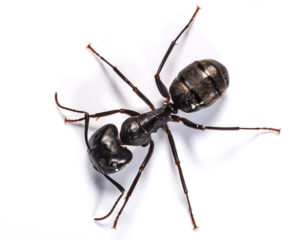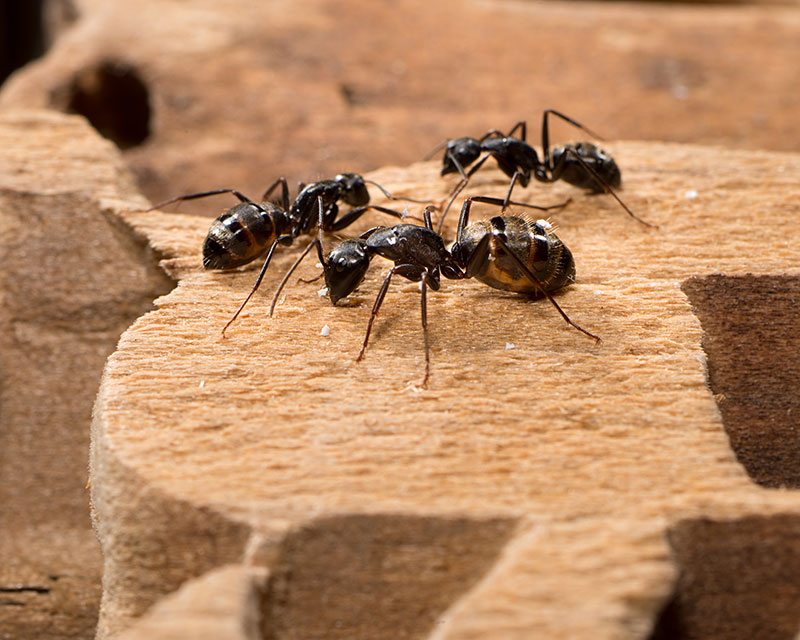
HEAD OFFICE
1261 Kennedy Rd Unit #5
Scarborough, ON M1P 2L4
Contact Info
info@advantagepestcontrol.co
416.840.4040
Carpenter Ants
Tips For Getting Rid Of Carpenter Ants
After a pesticide treatment, it is advisable to leave any dead ant bodies where they are. Other scavenging ants will either ingest or bring the dead ant back to the nest to feed the rest of the colony. In this way, the pesticide’s effect is passed on.
Our control methods have two major goals: elimination and prevention. Firstly we eliminate all carpenter ants from inside your home. Secondly we put a chemical barrier to prevent their return.
We recommend physical control as well as chemical control. This means reducing the amount of areas for harbouring carpenter ants in and around the home.
Once a colony is well established in your Toronto home, it is necessary to locate key areas and treat the home for permanent or long-term control.
How Do I Know I Have Carpenter Ants?
- Determine if there is actually an infestation of carpenter ants or if it is a case of individual ants wandering in the house.
- Look for a high concentration of ants in a particular area like under the kitchen sink.
- Listen for the sound of an active colony which will produce a dry rustling noise that can be heard best at night during high ant activity and quiet time in the house. The use of a wine glass or stethoscope can be helpful to listen to the walls.
- Notice if there are swarms of winged reproductive ants trying to escape to the outdoors, usually in the spring.

Carpenter Ant Colonies

A colony typically has one queen who begins the nest under a rock, in a tree hole or a tunnel in a tree. She will lay a few eggs which will hatch to be the first workers of the colony. These are the smallest ants of the colony called Minims. These minims are given the task of foraging for food and feeding the queen and any young she produces.[idea]The queen ant will lay 22 eggs in 15 days. It takes between 60 and 70 days to reach adult stage.[/idea]
During the spring, carpenter ant colonies will produce winged male and female ants that will fly out from the nest to start a new colony. this occurs when the colony needs to expand, generally when the colony numbers more than 2,000 workers. This is what is called “swarming” it can be both male and female winged ants or just males who are ‘evicted’ by worker ants.
Carpenter ants will travel great distances in their quest for food for the queen. They have been noted foraging up to 750 feet from the nest! Carpenter ants are commonly wingless, non-reproducing adults of the worker caste. All ants live in large groups or colonies consisting of hundreds of workers, a few reproductive males and females as well as at least one queen. Mating takes place in flight by winged ants during late spring and early summer. Shortly after, the male dies and the single fertilized queen ant finds a suitable nesting place to lay eggs and begin a new colony. The small, white, oval eggs hatch into larvae. The queen continues nourishment until the larvae pupate and adult ants emerge. If warm temperatures exist, the egg to adult cycle can be completed in three months. At first, the colony is small, however, in later years the population can increase to 2000-3000 ants.
Carpenter ants live both outdoors and indoors in moist, decaying or hollow wood. They create “galleries” into the wood grain to make passageways sot hey can move throughout the nest. Certain parts of a typical Toronto home, such as the windows, roof eaves, decks and porches, are more likely to be infested by carpenter ants because these areas are most vulnerable to moisture. Carpenter ants are the largest ants that are invading homes. They seek food and harbourage. They are a wide spread pest problems, spanning across North America.
Frequently Asked Questions
Q. How do you get rid of them?
A. Killing the visible ants foraging around a home is merely removing the symptoms. 90% of the ants never leave the nests. The nests must be located and destroyed.
Q. I heard noises in the wall and it turns out that the wall is full of ants, what are my options?
A. If you heard them they are likely carpenter ants. Your best option is to have a professional treat the entire house and locate all of the nests to treat the problem. Wall nests are usually eliminated by injecting a commercial residual insecticide into the cavities, from the exterior if possible.
Q. I had a spray for carpenter ants was wondering if the spray should kill the ants right away or do they carry the spray back to nest? I have seen several ants yesterday 2 days after the spraying.
A. It is common to see more ant activity after a carpenter ant treatment. Professionals use residual insecticides that do not kill the entire nest populations. Some of the survivors will wander around contaminating others in the colony. It is possible that one satellite nest may not have been found and treated but you should wait at least six weeks before requesting further treatment.
Q. I have a problem with flying ants in my daughters bedroom. I have three cats so i need to be careful what I use. How can I get rid these ants and do it quickly?
A. There are different control methods for various species of ants so you should first have them identified. If you are concerned about the health of your daughter and your cats, then you should not apply pesticides randomly. Some ants (Pharaoh) will split their colonies if you spray them. Some ants con be controlled with good quality baits placed in the right quantities in the right locations. Some will require considerable inspection to locate all of the satellite nests and treat them with residual insecticides. The safe and most effective solution would be to hire a qualified professional.
Q. Why would about a thousand flying (carpenter) ants suddenly appear in a room of our home and what do we do with them? Right now we closed the door. Its an addition put on years ago and we never had a problem, all the windows are shut tight.
A. Winged ants are reproductive males and females (future queens). They have been raised in a nest somewhere in your home and the nest has probably been there for at least 5 years. On warm days workers push out the smaller winged males because they think it is spring. Larger females will soon follow. These ants have only one purpose: to mate and start a new nest, but they are not destructive like the workers in the nest they have left. After fertilization, the males die and the females will seek a suitable place to start a new nest. It must be a damp location so they will fly to the windows trying to get outside. Use a vacuum cleaner to suck up the flying ants. They represent a very small percentage of the nest population. Call a professional to deal with the more serious problem: the nests of workers that may be causing structural damage.
Q. I live in a basement apartment. I have ants and no matter how much I spray they always seem to be waiting for a crumb of food. I have sprayed the outside area also hoping that would help. What can I use as a deterrent? I keep a very clean house and the ants are driving me crazy! Help! Cathy. Brooklyn, NY.
A. Killing ants outside the nest will seldom have any effect. You must identify the species of ant , find the nests, then apply the proper treatment. Spraying pesticides will cause some species to split up the nests making the problem even worse. A quality and bait works best for some species if properly placed and maintained over a period of time.
Q. Are there any insects that will chew through Styrofoam insulation?
A. Yes. Carpenter ants love to chew galleries in Styrofoam to create nests.
Q. We get a few ants in the house every spring / summer – no big deal. But now, all of a sudden, (it’s mid-May) – our wooden deck has been taken over by those wretched carpenter ants. Called one pest control company and – get this – they actually recommended that we tear up the deck and install a new one. Our house is at the bottom of a slight hill and the hill (not our property) is covered in trees. I’ve read everything I can find about carpenter ants so I know it’s not an easy solution to get rid of them. I have sprayed the foundation of the house with ant repellant – I know it won’t solve the problem but will hopefully keep the ants from invading the house. Do you have any suggestions as to how we can do something (anything!) about our deck problem?
A. It sounds like you may have called the wrong pest control business. Did they look at the deck and is it structurally sound? The ants you are seeing may be coming out of the house to forage for food, not trying to move in. If the deck flashing is defective it is common to find carpenter ants in a structure where the deck joins. This can be treated without tearing apart the deck. Read more about carpenter ants. Talk to some other professionals listed in our directory.
Q. When carpenter ants fly, do they fly smoothly, or do they kind of jump around and not really take off and fly at all?
A. Carpenter ants (reproductive males and females with wings) do not fly well. When leaving a nest indoors they sometimes drop to a lower surface eventually trying to fly outside. That is why they are often found gathered at windows. Reproductive carpenter ants are not destructive. They have only one thing on their mind and it is not chewing wood
Powered by Ripe Web.

